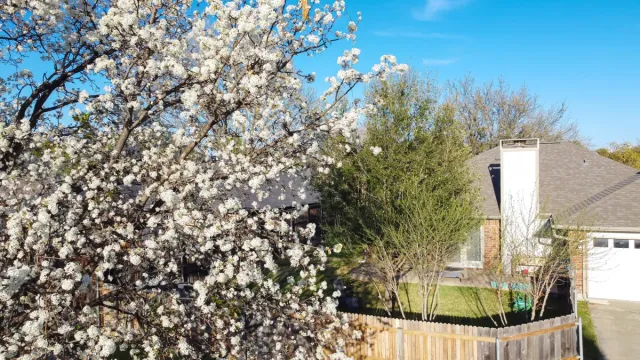States Are Banning a Tree You Might Have in Your Yard

The spring season has finally begun, and many of us are busy tending to our yards. You might be figuring out what flowers you want to plant, or trying to determine which plants are posing a problem for your allergies. But your garden could be harboring one plant that experts say shouldn’t be there at all, as many states are now banning a tree that you might have in your yard.
RELATED: 5 Invasive Trees You Need to Remove From Your Yard Immediately.
The white blooms of Bradford pear trees mark the arrival of the spring season in many areas. After being promoted as an inexpensive ornamental plant for landscaping in the ’60s, they’ve become a common sight in countless yards, according to Mississippi State University (MSU).
But the Bradford pear tree is not native to the U.S. It is, in fact, a variant of the Callery pear species from China that was introduced into our country by U.S. Agriculture Department scientists and has since become invasive, The Washington Post reported.
When something is deemed invasive, that means it is a “non-native species that causes harm to the environment, economy, or human, animal, or plant health,” the National Park Service (NPS) explains on its website.
But how did Bradford pear trees become invasive? According to the University of Arkansas’ Division of Agriculture (UADA), these trees were believed to be sterile when they were originally introduced to the country. And while that’s technically true, scientists have since found that Bradford pear trees can quickly and easily cross pollinate with other Callery pear variants.
“The resulting trees create thorny thickets that have many negative impacts on our native tree populations,” the UADA website explains.
Concerns over the implications of this invasive species are now coming to a head, as officials have started to target Bradford pear trees and other iterations of the Callery pear in several parts of the country, USA Today reported.
“It’s really easy to just drive down the road and see how much it is spreading,” Lori Chamberlin, forest health program manager for the Virginia Department of Forestry (DOF), told the newspaper. “It really does well along disturbed areas so along roadsides, along fields and along forest edges. In some cases we are seeing it actually invade forests. It’s displacing native tree species and preventing native trees from growing.”
RELATED: 7 Plants You Can Buy That Are Actually Dangerous Invasive Species.
Virginia is one of the states that have added the Callery pear to their lists of invasive plants, and in April, the state’s DOF is hosting its first tree exchange to “promote the removal of these invasive tress from the urban landscape to reduce their ability to spread” by providing Virginia landowners with a native tree as a replacement.
Other states have also put Callery pear trees on their invasive plants lists, according to USA Today. But some have gone even further to stop the spread.
Ohio has banned the Callery pear entirely, making it illegal to sell, grow, or plant in the state as of Jan. 1, 2023.
Just last month, Pennsylvania also began fully enforcing a ban on the sale and distribution of Callery pear trees, and the Kansas Department of Agriculture approved a quarantine on the trees. The quarantine will take effect on Jan. 1, 2027, and prohibit these trees from being moved within or brought into this state.
South Carolina is also set to ban the Bradford pear later this year. Starting Oct. 1, 2024, the nursery sale of Bradford pear trees and any other pear trees grown on the commonly used Pyrus calleryana rootstock will be illegal in the state.
“There are several ways to attack the problem, and one of those ways is to just stop it from being sold,” David Coyle, assistant professor of Forest Health and Invasive Species at Clemson University in South Carolina, said in a statement when the ban was passed.
“As part of Clemson Extension’s Bradford Pear Bounty program, we’re trying to teach consumers that there are better things to plant and, essentially, teach them not to buy those non-native species,” Coyle explained. “But you can’t reach everyone that way, so we’re trying to come at it from another way and just make it illegal to sell them.”
- Source: MSU: The Fishy Truth about Bradford Pear Trees
- Source: NPS: What Are Invasive Species?
- Source: UADA: Invasive Plants
- Source: Virginia DOF: Callery Pear Exchange Program
- Source: Ohio Department of Natural Resources: Callery Pear
- Source: Pennsylvania Department of Agriculture: Callery Pear
- Source: Kansas Department of Agriculture: Callery Pear Quarantine